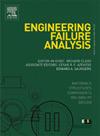Study on the impact toughness and crack propagation behavior of Ti microalloyed weathering steel laser-MAG hybrid welded joints
IF 4.4
2区 工程技术
Q1 ENGINEERING, MECHANICAL
引用次数: 0
Abstract
In this work, the effect of Ti microalloying on the impact toughness of weathering steel laser-MAG hybrid welded joints was investigated and the corresponding crack initiation and propagation mechanisms were revealed. The results show that the impact toughness of heat affect zone (HAZ) increased by 39.4% and weld metal (WM) by 70.9% compared to Ti-free weathering steel welded joints. The degree of improvement in impact toughness gradually increases with the direction from BM (base metal) to WM. In the WM, Ti element can refine the precipitations and reduce the shape and size of M−A constituents. Furthermore, the microstructure in the WM exhibits the obvious preferred orientations, i.e., the maximum IPF intensity value are concentrated around the [111] pole (the slip direction of BCC structure), which is more prone to slip under external forces. In the HAZ, the addition of Ti mainly plays a role in decreasing the size of precipitations, inducing AF precipitation and increasing the homogeneity of grain size. Therefore, the impact toughness of WM and HAZ for Ti microalloyed weathering steel welded joints is improved by hindering the crack propagation. In addition, in the WM, the main crack path is flatter and the number of secondary cracks is more than that in the HAZ, indicating that the impact toughness of WM is poorer.
钛微合金耐候钢激光-MAG 混合焊接接头的冲击韧性和裂纹扩展行为研究
本文研究了 Ti 微合金化对耐候钢激光-MAG 混合焊接接头冲击韧性的影响,并揭示了相应的裂纹萌发和扩展机制。结果表明,与不含 Ti 的耐候钢焊接接头相比,热影响区 (HAZ) 的冲击韧性提高了 39.4%,焊缝金属 (WM) 的冲击韧性提高了 70.9%。冲击韧性的改善程度随着从 BM(母材)到 WM 的方向逐渐增加。在 WM 中,Ti 元素可以细化析出物,减少 M-A 成分的形状和尺寸。此外,WM 中的微观结构表现出明显的优先取向,即最大 IPF 强度值集中在 [111] 极(BCC 结构的滑移方向)周围,在外力作用下更容易发生滑移。在 HAZ 中,Ti 的添加主要起到减小析出物尺寸、诱导 AF 沉淀和增加晶粒尺寸均匀性的作用。因此,Ti 微合金耐候钢焊接接头的 WM 和 HAZ 的冲击韧性可通过阻碍裂纹扩展而得到改善。此外,与 HAZ 相比,WM 的主裂纹路径更平坦,次裂纹数量更多,表明 WM 的冲击韧性更差。
本文章由计算机程序翻译,如有差异,请以英文原文为准。
求助全文
约1分钟内获得全文
求助全文
来源期刊

Engineering Failure Analysis
工程技术-材料科学:表征与测试
CiteScore
7.70
自引率
20.00%
发文量
956
审稿时长
47 days
期刊介绍:
Engineering Failure Analysis publishes research papers describing the analysis of engineering failures and related studies.
Papers relating to the structure, properties and behaviour of engineering materials are encouraged, particularly those which also involve the detailed application of materials parameters to problems in engineering structures, components and design. In addition to the area of materials engineering, the interacting fields of mechanical, manufacturing, aeronautical, civil, chemical, corrosion and design engineering are considered relevant. Activity should be directed at analysing engineering failures and carrying out research to help reduce the incidences of failures and to extend the operating horizons of engineering materials.
Emphasis is placed on the mechanical properties of materials and their behaviour when influenced by structure, process and environment. Metallic, polymeric, ceramic and natural materials are all included and the application of these materials to real engineering situations should be emphasised. The use of a case-study based approach is also encouraged.
Engineering Failure Analysis provides essential reference material and critical feedback into the design process thereby contributing to the prevention of engineering failures in the future. All submissions will be subject to peer review from leading experts in the field.
 求助内容:
求助内容: 应助结果提醒方式:
应助结果提醒方式:


